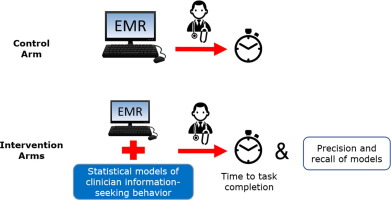当前位置:
X-MOL 学术
›
J. Biomed. Inform.
›
论文详情
Our official English website, www.x-mol.net, welcomes your
feedback! (Note: you will need to create a separate account there.)
Using machine learning to selectively highlight patient information.
Journal of Biomedical informatics ( IF 4.0 ) Pub Date : 2019-10-29 , DOI: 10.1016/j.jbi.2019.103327 Andrew J King 1 , Gregory F Cooper 2 , Gilles Clermont 3 , Harry Hochheiser 2 , Milos Hauskrecht 4 , Dean F Sittig 5 , Shyam Visweswaran 2
Journal of Biomedical informatics ( IF 4.0 ) Pub Date : 2019-10-29 , DOI: 10.1016/j.jbi.2019.103327 Andrew J King 1 , Gregory F Cooper 2 , Gilles Clermont 3 , Harry Hochheiser 2 , Milos Hauskrecht 4 , Dean F Sittig 5 , Shyam Visweswaran 2
Affiliation

|
BACKGROUND
Electronic medical record (EMR) systems need functionality that decreases cognitive overload by drawing the clinician's attention to the right data, at the right time. We developed a Learning EMR (LEMR) system that learns statistical models of clinician information-seeking behavior and applies those models to direct the display of data in future patients. We evaluated the performance of the system in identifying relevant patient data in intensive care unit (ICU) patient cases.
METHODS
To capture information-seeking behavior, we enlisted critical care medicine physicians who reviewed a set of patient cases and selected data items relevant to the task of presenting at morning rounds. Using patient EMR data as predictors, we built machine learning models to predict their relevancy. We prospectively evaluated the predictions of a set of high performing models.
RESULTS
On an independent evaluation data set, 25 models achieved precision of 0.52, 95% CI [0.49, 0.54] and recall of 0.77, 95% CI [0.75, 0.80] in identifying relevant patient data items. For data items missed by the system, the reviewers rated the effect of not seeing those data from no impact to minor impact on patient care in about 82% of the cases.
CONCLUSION
Data-driven approaches for adaptively displaying data in EMR systems, like the LEMR system, show promise in using information-seeking behavior of clinicians to identify and highlight relevant patient data.
中文翻译:

使用机器学习有选择地突出显示患者信息。
背景技术电子病历(EMR)系统需要通过在正确的时间将临床医生的注意力吸引到正确的数据来减少认知超负荷的功能。我们开发了一个学习 EMR (LEMR) 系统,该系统可以学习临床医生信息寻求行为的统计模型,并应用这些模型来指导未来患者的数据显示。我们评估了系统在识别重症监护病房 (ICU) 患者病例中相关患者数据方面的性能。方法 为了捕捉信息寻求行为,我们招募了重症监护医学医生,他们审查了一组患者病例并选择了与早间查房任务相关的数据项。使用患者 EMR 数据作为预测因子,我们构建了机器学习模型来预测其相关性。我们前瞻性地评估了一组高性能模型的预测。结果 在独立评估数据集上,25 个模型在识别相关患者数据项时达到了 0.52、95% CI [0.49, 0.54] 的精确度和 0.77、95% CI [0.75, 0.80] 的召回率。对于系统遗漏的数据项目,审核人员将约 82% 的案例中看不到这些数据的影响从对患者护理没有影响到轻微影响进行了评级。结论 在 EMR 系统(如 LEMR 系统)中自适应显示数据的数据驱动方法在利用临床医生的信息查找行为来识别和突出显示相关患者数据方面显示出前景。
更新日期:2019-10-29
中文翻译:

使用机器学习有选择地突出显示患者信息。
背景技术电子病历(EMR)系统需要通过在正确的时间将临床医生的注意力吸引到正确的数据来减少认知超负荷的功能。我们开发了一个学习 EMR (LEMR) 系统,该系统可以学习临床医生信息寻求行为的统计模型,并应用这些模型来指导未来患者的数据显示。我们评估了系统在识别重症监护病房 (ICU) 患者病例中相关患者数据方面的性能。方法 为了捕捉信息寻求行为,我们招募了重症监护医学医生,他们审查了一组患者病例并选择了与早间查房任务相关的数据项。使用患者 EMR 数据作为预测因子,我们构建了机器学习模型来预测其相关性。我们前瞻性地评估了一组高性能模型的预测。结果 在独立评估数据集上,25 个模型在识别相关患者数据项时达到了 0.52、95% CI [0.49, 0.54] 的精确度和 0.77、95% CI [0.75, 0.80] 的召回率。对于系统遗漏的数据项目,审核人员将约 82% 的案例中看不到这些数据的影响从对患者护理没有影响到轻微影响进行了评级。结论 在 EMR 系统(如 LEMR 系统)中自适应显示数据的数据驱动方法在利用临床医生的信息查找行为来识别和突出显示相关患者数据方面显示出前景。











































 京公网安备 11010802027423号
京公网安备 11010802027423号